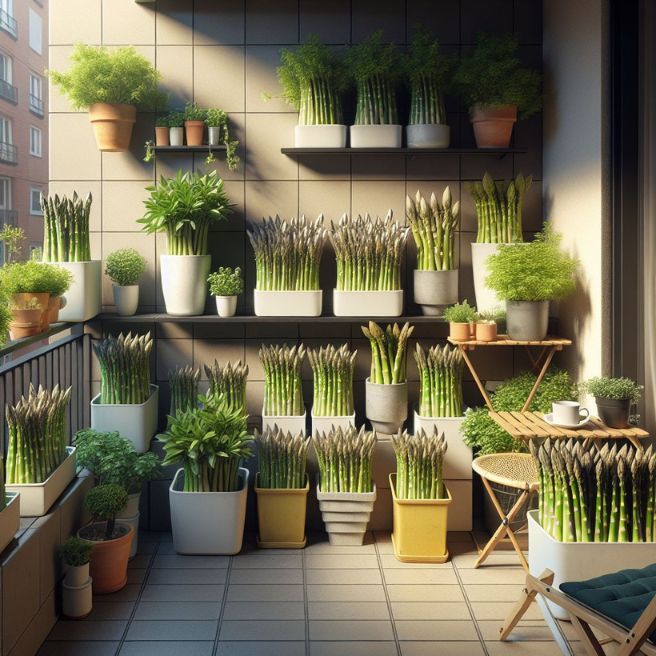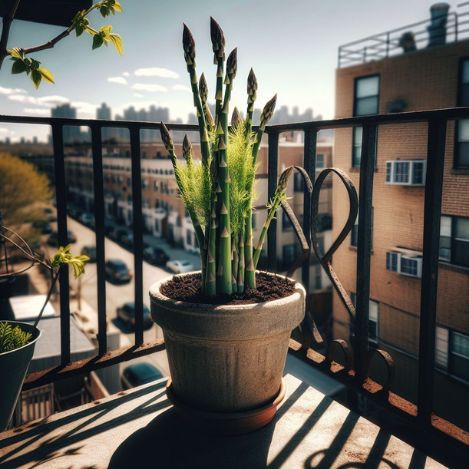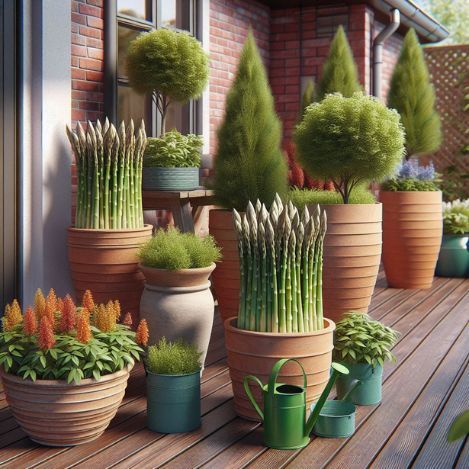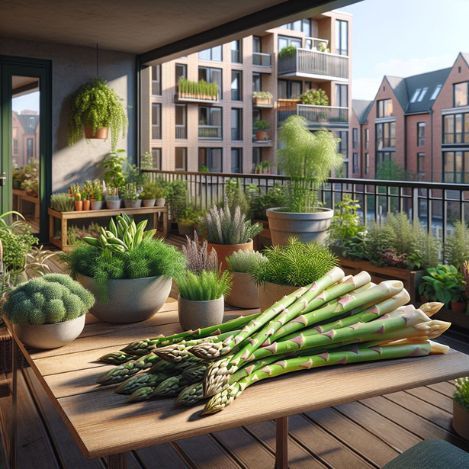
Key Takeaways
Container gardening allows you to grow asparagus even in limited spaces.
Mary Washington asparagus is a popular variety known for its high yields and disease resistance.
Choosing the right container, soil, and location is crucial for healthy asparagus growth.
Proper planting and care lead to a bountiful harvest of asparagus for years to come.
With patience and attention, even beginners can successfully grow asparagus in containers.
- Sprouting Up: The Asparagus Container Garden Adventure
Imagine stepping outside to your sunny patio where a row of lush, green asparagus ferns sway gently in the breeze. You reach down and snap off a tender, home-grown spear. This isn’t just a dream for those with sprawling garden plots; it’s a reality for container gardeners too! Growing asparagus in containers is a fantastic way to enjoy this perennial favorite, no matter the size of your outdoor space.
Why Container Gardening Might Be Your New Veggie Plot
Why choose containers for asparagus? It’s simple. Containers offer flexibility. You can control the soil, move the plants to catch the sun, and manage pests more easily. Plus, for those with poor soil quality or limited garden space, containers can be a game-changer, allowing you to cultivate plants that might otherwise struggle to thrive.
Asparagus 101: The Basics of This Perennial Plant
Asparagus, with its feathery foliage and succulent spears, is a perennial plant that, once established, can produce for 20 years or more. It’s a long-term relationship, so getting the setup right is key. You plant once and harvest year after year, so think of it as an investment in your future meals.
Container Considerations for Asparagus Aficionados
Before you get started, let’s get down to the root of the matter. Containers for asparagus need to be deep. This plant has a robust root system that loves to stretch out. Therefore, opt for pots that are at least 12-14 inches deep. But remember, bigger is better in this case.
Picking the Perfect Pot for Your Spear Squad
When selecting a container, size matters, but so does material. Plastic pots are lightweight and inexpensive, but they can deteriorate over time. Ceramic or terracotta pots are heavier and provide good stability against strong winds, but they’re also more prone to cracking in freezing temperatures. Metal containers can get too hot, cooking the roots on a scorching day. Wooden planters offer a happy medium, insulating roots from extreme temperatures and adding a rustic charm to your space.
Soil Setup: Creating the Ideal Environment
The right soil mix is crucial. Asparagus prefers well-drained, nutrient-rich soil. A mix of potting soil, compost, and perlite or sand will give your plants the drainage they need while holding onto enough moisture to keep the roots happy. Remember, soil that’s too dense can lead to waterlogged roots and a sad asparagus plant.
Most importantly, the pH of your soil should be slightly alkaline, around 6.5 to 7.5. You can easily test this with a soil pH test kit from your local garden center. If you need to raise the pH, consider adding a bit of lime to your soil mix.
The Importance of Drainage and Sunlight
Drainage holes are a must in your containers to prevent water from pooling at the bottom. As for sunlight, asparagus loves a full day’s worth. Aim for at least 6-8 hours of direct sunlight. If you’re short on sunny spots, don’t worry. Asparagus can tolerate partial shade, but the spears might not be as robust.
Meet Mary Washington: Your Asparagus Variety Spotlight

Let’s talk about Mary Washington asparagus. This heirloom variety has been the backbone of many gardens for generations. It’s known for its thick, tender spears and resistance to common asparagus diseases like rust and fusarium wilt. Plus, it’s an open-pollinated variety, which means you can save seeds from the ferns to plant next year.
Resistant to common diseases
Produces thick, tender spears
Open-pollinated, allowing seed saving
When comparing Mary Washington to other varieties, like the Jersey series or Purple Passion, it stands out for its hardiness and consistent production. So if you’re looking for a reliable and flavorful asparagus variety for your container garden, Mary Washington is a solid choice.
Steps to Success: Planting Asparagus in Containers
Now, let’s dive into the heart of the matter: planting your asparagus. The right start can lead to years of plentiful harvests. The first step is to source quality crowns, which are the root systems of one-year-old plants. This gives you a head start compared to planting seeds.
Timing and Temperature: When to Plant
Timing is everything. Plant your asparagus crowns in early spring as soon as the soil can be worked. Asparagus doesn’t like to have cold feet, so wait until the threat of frost has passed. The soil temperature should ideally be around 50°F (10°C) for the crowns to settle in comfortably.
The Planting Process: A Walkthrough
First, prepare your container by filling it with your soil mix and creating a mound in the center. Place the crown on top of the mound, spreading the roots down the sides. Cover the roots with soil, leaving the tips of the crowns just peeking through. As the asparagus grows, continue to add soil until the container is full.
Here’s a simple step-by-step guide:
Fill the container with soil mixture, leaving several inches from the top.
Create a small mound in the center of the container.
Place the asparagus crown on the mound, draping roots downward.
Cover with soil so the crown is just below the surface.
Water thoroughly after planting.
Add more soil as the plant grows, until the container is filled to the brim.
After planting, water your asparagus well to settle the soil around the roots and eliminate any air pockets. Keep the soil moist but not waterlogged as the crowns establish themselves.
Caring for Your Asparagus: Water, Feed, Repeat
Asparagus plants aren’t high-maintenance, but they do appreciate consistent care. Water them regularly to keep the soil moist. During the first growing season, focus on developing strong roots, so avoid harvesting any spears. Feed your plants with a balanced fertilizer in early spring and again after the harvest season.
Tending to Your Tall Greens: Ongoing Care and Tips

As your asparagus plants mature, they’ll need ongoing care to produce the best spears. Keep an eye out for weeds that can compete for nutrients and water. Mulching around the plants can help suppress weeds and retain soil moisture.
Asparagus plants are ferny and can grow quite tall, so they might need support, especially in windy locations. A stake or trellis can help keep them upright.
Most importantly, allow the ferns to grow after the harvest period. They’re not just there for show; they help the plant store energy for the next growing season. In the fall, once the foliage has died back, cut it to ground level to tidy up and reduce the risk of disease.
Example: One gardener I know used a large wooden whiskey barrel as a container for her asparagus. She followed these exact steps and has been enjoying a bountiful harvest for over five years now!
Spotting and Solving Common Asparagus Issues
Even with the best care, you might encounter a few bumps along the way. Common issues include yellowing foliage, which can be a sign of too much water or poor drainage. If your asparagus spears are skinny, they might need more nutrients or it could be time to divide your plants.
If you notice chewed foliage or spears, it might be the work of asparagus beetles. These pests can be controlled by hand picking or using an appropriate insecticide. Always follow the label’s instructions and opt for organic solutions when possible.
The Waiting Game: Patience is crucial when it comes to growing asparagus in containers.
Asparagus teaches us patience. It’s not a crop you can rush. In the first year, let the plants grow without harvesting any spears. This allows the plants to focus on establishing a strong root system. By the second year, you can harvest a few spears, but the real bounty comes in the third year and beyond. So, hold off on the harvest initially, and your taste buds will thank you later.
When and How to Harvest Your Asparagus
Harvest time is a joyous occasion. When your asparagus is ready, you’ll see spears that are about 6-8 inches tall and as thick as a pencil. To harvest, simply snap the spears off at the base or cut them with a sharp knife. Be gentle to avoid damaging the plant. Harvest in the morning when the spears are most tender, and enjoy the fruits of your labor fresh for the best flavor.
Enjoying Your Bounty: From Garden to Table

After the wait, it’s time to savor your success. Fresh asparagus can be steamed, grilled, roasted, or eaten raw in salads. The flavor of home-grown spears is incomparable to store-bought ones. Remember, asparagus is best enjoyed soon after harvesting, so plan your meals accordingly and indulge in the freshness.
But besides fresh eating, asparagus can also be preserved. Blanching and freezing is a great way to maintain the quality of your harvest. You can also pickle asparagus for a tangy treat that lasts months. Whichever way you choose to enjoy it, the satisfaction of eating your home-grown asparagus is unbeatable.
Frequently Asked Questions
Now that you’re equipped with the knowledge to grow asparagus in containers, you might still have some questions. Let’s tackle some common queries to give you that extra confidence boost.
Can asparagus really thrive in containers?
Yes, asparagus can thrive in containers, provided they have enough depth for the roots to grow and are placed in a sunny location. With proper care, container-grown asparagus can be just as successful as those planted in the ground.
How many years will my container asparagus produce spears?
A well-maintained asparagus plant can produce spears for up to 20 years.
Regular feeding and proper care are essential for longevity.
Asparagus plants in containers may need to be divided or repotted every few years to maintain vigor.
With the right conditions and care, your asparagus plants will reward you with spears for many seasons to come.
What size container is best for growing asparagus?
Choose a container that is at least 12-14 inches deep and 12-18 inches in diameter for each asparagus plant. Larger containers are even better, as they provide more room for the roots to spread and can hold more plants for a bigger harvest.
How often should I water my asparagus plants?
Water your asparagus plants to keep the soil consistently moist but not waterlogged. During the growing season, this usually means watering once or twice a week, depending on the weather and soil conditions. Always check the soil moisture level before watering.
Is Mary Washington asparagus resistant to pests and diseases?
Mary Washington asparagus is known for its resistance to common pests and diseases, such as asparagus rust and fusarium wilt. However, no plant is completely immune, so it’s important to monitor your plants and maintain good cultural practices to prevent issues.
In conclusion, growing asparagus in containers is not only possible but also incredibly rewarding. With Mary Washington asparagus, you have a variety that’s tried and true, perfect for container gardening. Now that you know the steps and care involved, why not give it a try? Embrace the challenge, and before long, you’ll be enjoying the delicious rewards of your very own asparagus garden. And when you’re ready to get started, head over to Survival Essentials for all your gardening needs.







Leave a Reply